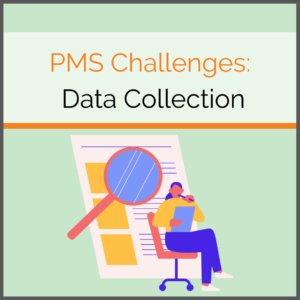
The module for Vigilance and Post-Market Surveillance (PMS) is one of the six modules of EUDAMED. While the proof of medical device safety in the MDD (Directive 93/42/EEC) was still handled quite loosely, the term post-market surveillance is very clearly defined in the Medical Device Regulation (MDR). According to the MDR, manufacturers are obliged to analyze customer complaints and evaluate reports from vigilance systems such as EUDAMED. They must also continuously collect and evaluate data on the safety, performance, and risk-benefit ratio of the medical devices they sell. The research and collection of data required for this regularly presents medical device manufacturers with a challenge.
Monitoring medical devices through proactive and reactive data collection is of immense importance for ensuring patient safety. However, the personnel effort and the associated costs are often difficult to manage. Literature research and data analysis can be time-consuming. On the one hand, there is a high number of possible data and a variety of data sources, and on the other hand, the process of distinguishing relevant from irrelevant information. A standardized procedure would make the process of data research and evaluation more efficient.
Information Exchange between departments
Cross-functional collaboration is a challenge for almost all areas of a company – including post-market surveillance data collection. Within medical technology companies, the department responsible for data collection can often be thematically isolated from other departments. However, important knowledge and information can also be found among non-topic colleagues. Perhaps a colleague reads an article on LinkedIn, or another from sales hears about an incident in a conversation with a customer. Effective collaboration within the team is just as important. Be it to avoid duplicating information or to evaluate data according to the dual control principle. To make the collection of data efficient, a company must establish a functioning methodology. It improves the exchange of information between departments and individuals. The creation of standard operating procedures (SOPs) and the maintenance of an internal company database can be helpful. Ideally with an audit trail and the option to assign tasks to colleagues.
Choosing the Correct Literature Database
Various data sources may be used, depending on the type of medical device and the maturity of its technology. . If it is a rare product or a very innovative technology, there are often only a few relevant articles in large databases such as Pubmed. As a result, it is not uncommon to sift through many texts before finding the relevant ones.
In the case of established medical products, a glance at the authors of the specialist articles is often enough. It reveals whether the product originates from the company itself or whether the underlying technology is comparable to the medical device sold by the company itself.
Creating a Search Query
Creating search queries in literature databases for post-market surveillance data collection can be a particular challenge, depending on the experience of the team and their knowledge of the medical device in question. The aim is to narrow down the amount of literature without excluding important articles by limiting the search too much. If you are familiar with the significant variations of a term, database specifications, and how to use Boolean operators such as “AND”, “OR” and “NOT”, the search is easier. Therefore, the European Union recommends standardizing the literature search process by developing and testing defined search queries.
Dealing With Duplicates
Often, countless duplicates of specialist articles are collected during literature searches. This is also the case with a standardized search. As a rule, these are duplicate citations resulting from the inclusion of secondary sources such as systematic reviews or meta-analyses in the literature search. One way of dealing with duplicates is to perform a very time-consuming manual search of the literature by title, abstract, authors, journal, and year of publication. If a modern literature management program is used, duplicates are automatically identified and sorted out after confirmation by the user. This variant is less time-consuming to do manually. However, the purchase of such a software tool is associated with costs.
Overcoming the Challenges of Post-Market Surveillance
A systematic approach helps to make post-market surveillance data collection more efficient and standardized. Five steps come into play here:
- Researching papers in data sources
- Removal of duplicates
- Screening and sorting based on titles and abstracts
- Application of inclusion and exclusion criteria to complete texts
- Evaluation of the remaining articles
The introduction of a standardized keyword catalog is an ideal starting point for improving the process of researching papers. This will make the search more accurate and less time-consuming. Search algorithms can also be of use here.
The development of a criteria catalog helps with the removal of duplicates and the screening and sorting of literature. Papers can be classified as relevant or irrelevant based on titles and abstracts. Software-based text analysis methods might come in handy at this point.
Once the pre-sorting has been completed, the complete texts of the papers are reviewed using inclusion and exclusion criteria. If it is deemed appropriate to adjust the exclusion criteria, an iterative approach is recommended. The criteria are adapted and tested until, at best, only literature with relevant information remains. Software-based relevance analyses are also able to efficiently adapt the exclusion criteria. Such analyses can also be used for the final selection of articles to be included.
Artificial intelligence (AI) can automate each of these steps. It can be used to create and optimize a keyword catalog or search algorithms, analyze texts, and support the evaluation process. AI is ideal for literature research and data screening within post-market surveillance, simplifying processes, and saving companies time and money.